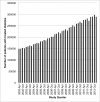Trends in Antihyperglycemic Medication Prescriptions and Hypoglycemia in Older Adults: 2002-2013
- PMID: 26335938
- PMCID: PMC4559313
- DOI: 10.1371/journal.pone.0137596
Trends in Antihyperglycemic Medication Prescriptions and Hypoglycemia in Older Adults: 2002-2013
Abstract
Background: Over the last decade, several new antihyperglycemic medications have been introduced including those associated with a lower hypoglycemia risk. We aimed to investigate how these medications are being prescribed to older adults in our region.
Methods: We conducted population-based cross-sectional analyses of older adults (mean age 75 years) with treated diabetes in Ontario, Canada from 2002 until 2013, to examine the percentage prescribed insulin, sulphonylureas, alpha-glucosidase inhibitors, metformin, thiazolidinediones, meglitinides, and dipeptidyl peptidase-4 inhibitors. Over the study period, we also examined their hospital encounters for hypoglycemia (emergency room or inpatient encounter).
Results: The mean age of treated patients increased slightly over the study quarters and the proportion that were women declined. With the exception of chronic kidney disease, cancer, dementia, and neuropathy, the percentage with a comorbidity appeared to decline. The percentage of treated patients prescribed metformin, gliclazide and dipeptidyl peptidase-4 inhibitors increased as did combination therapy. Glyburide and thiazolidinedione prescriptions declined, and insulin use remained stable. In those with newly treated diabetes, the majority were prescribed metformin, with smaller percentages prescribed insulin and other oral agents. Although the absolute number of treated patients with a hypoglycemia encounter increased until mid-2006 and then decreased, the overall percentage with an encounter declined over the study period (0.8% with an event in the first quarter, 0.4% with an event in the last quarter).
Conclusions: Antihyperglycemic medications with safer profiles are being increasingly prescribed to older adults. In this setting there has been a decrease in the percentage of treated patients with a hospital encounter for hypoglycemia.
Conflict of interest statement
Figures



Similar articles
-
Secular trends in antihyperglycaemic medication prescriptions in older adults with diabetes and chronic kidney disease: 2004-2013.Diabetes Obes Metab. 2016 Jun;18(6):607-14. doi: 10.1111/dom.12658. Epub 2016 Apr 12. Diabetes Obes Metab. 2016. PMID: 26939711
-
The Hypoglycemic Risk of Glyburide (Glibenclamide) Compared with Modified-Release Gliclazide.Can J Diabetes. 2015 Aug;39(4):308-16. doi: 10.1016/j.jcjd.2015.01.001. Epub 2015 Mar 31. Can J Diabetes. 2015. PMID: 25840942
-
Changing Patterns of Glucose-Lowering Medication Use in VA Nursing Home Residents With Diabetes, 2005 to 2011.J Am Med Dir Assoc. 2015 Oct 1;16(10):898.e9-14. doi: 10.1016/j.jamda.2015.06.020. Epub 2015 Aug 10. J Am Med Dir Assoc. 2015. PMID: 26272298 Free PMC article.
-
Safe and appropriate use of insulin and other antihyperglycemic agents in hospital.Can J Diabetes. 2014 Apr;38(2):94-100. doi: 10.1016/j.jcjd.2014.01.002. Can J Diabetes. 2014. PMID: 24690504 Review.
-
Dipeptidyl peptidase-4 inhibitors in the elderly: more benefits or risks?Adv Ther. 2012 Mar;29(3):218-33. doi: 10.1007/s12325-012-0008-x. Epub 2012 Mar 8. Adv Ther. 2012. PMID: 22411425 Review.
Cited by
-
Global burden of hypoglycaemia-related mortality in 109 countries, from 2000 to 2014: an analysis of death certificates.Diabetologia. 2018 Jul;61(7):1592-1602. doi: 10.1007/s00125-018-4626-y. Epub 2018 May 1. Diabetologia. 2018. PMID: 29717336 Free PMC article.
-
Dose distribution and up-titration patterns of metformin monotherapy in patients with type 2 diabetes.Endocrinol Diabetes Metab. 2019 Dec 17;3(1):e00107. doi: 10.1002/edm2.107. eCollection 2020 Jan. Endocrinol Diabetes Metab. 2019. PMID: 31922032 Free PMC article.
-
Efficacy and safety of evogliptin monotherapy in patients with type 2 diabetes and moderately elevated glycated haemoglobin levels after diet and exercise.Diabetes Obes Metab. 2017 Dec;19(12):1681-1687. doi: 10.1111/dom.12987. Epub 2017 Jul 7. Diabetes Obes Metab. 2017. PMID: 28448688 Free PMC article. Clinical Trial.
-
Nonsevere Hypoglycemia Episode Clinical and Economic Outcomes: A Comparison between Sulfonylurea and Sodium-Glucose Cotransporter 2 Inhibitor as Add-On to Metformin from a Canadian Perspective.Int J Endocrinol. 2018 Jul 8;2018:3718958. doi: 10.1155/2018/3718958. eCollection 2018. Int J Endocrinol. 2018. PMID: 30123259 Free PMC article. Review.
-
Comparative Safety of Dipeptidyl Peptidase-4 Inhibitors Versus Sulfonylureas and Other Glucose-lowering Therapies for Three Acute Outcomes.Sci Rep. 2018 Oct 11;8(1):15142. doi: 10.1038/s41598-018-33483-y. Sci Rep. 2018. PMID: 30310100 Free PMC article.
References
-
- Rathmann W, Haastert B, Icks A, Giani G. Trends in outpatient prescription drug costs in diabetic patients in Germany, 1994–2004. Diabetes Care. 2007;30:848–53. - PubMed
-
- Van Staa T, Abenhaim L, Monette J. Rates of hypoglycemia in users of sulfonylureas. J Clin Epidemiol. 1997;50:735–41. - PubMed
-
- Rosenstock J, Wilson C, Fleck P. Alogliptin versus glipizide monotherapy in elderly type 2 diabetes mellitus patients with mild hyperglycaemia: A prospective, double-blind, randomized, 1-year study. Diabetes, Obes Metab. 2013;15:906–14. - PubMed
Publication types
MeSH terms
Substances
LinkOut - more resources
Full Text Sources
Other Literature Sources
Medical

